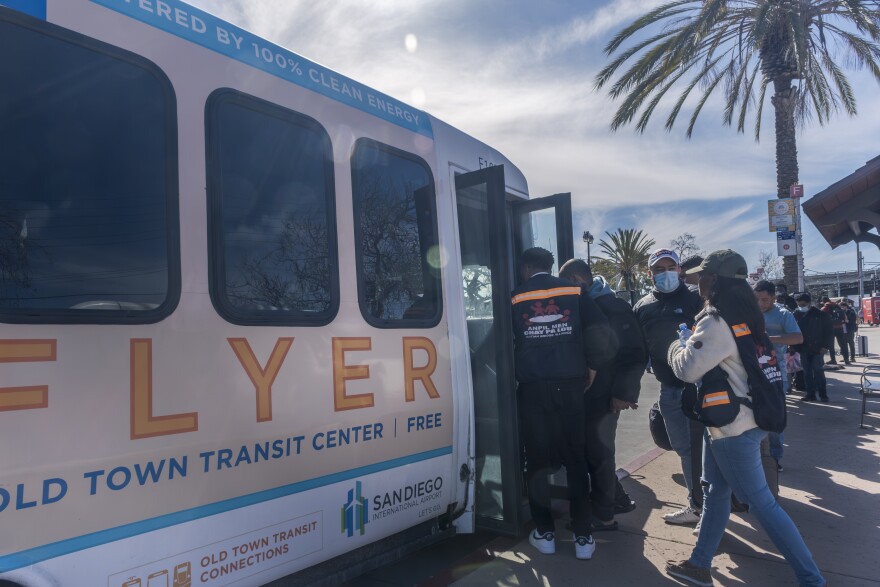After San Diego County shut down its Migrant Welcome Center this week, Customs and Border Protection (CBP) officials have once again begun dropping migrants off on San Diego streets.
CBP dropped off more than 300 migrants at the Iris Transit Station in San Ysidro Friday morning.
They were cold, hungry and tired. Many of them slowly reinserted their shoelaces back into their shoes after unloading their bags from CBP buses — a clear sign that they had been in custody.
That was the case for a 19-year-old Colombian asylum seeker named Felipe, who asked to not use his full name. He crossed the border with his parents, grandmother and younger siblings earlier this week near Jacumba. The family slept outside in near-freezing temperatures before turning themselves over to Border Patrol agents.
Because he’s technically an adult, Felipe was separated from his family and placed in a detention space with others traveling alone.
“They separated us,” he said in Spanish. “I don’t know where they are, I don’t know anything right now.”
Felipe didn’t have a phone or any other way of contacting them. Still, he was relieved to finally be in the United States.
“It feels good,” he said. “I feel a little calmer.”
Iris Transit Center doesn’t have the infrastructure to welcome hundreds of migrants. There is no shelter, public restrooms, benches or access to Wi-Fi.
Under normal circumstances, migrants like Felipe would have been taken to the Migrant Welcome Center, which was funded by $6 million from San Diego County. That center serviced more than 81,000 migrants between February and March, according to SBCS, the nonprofit that ran the operation.
But that center closed Thursday. Now, CBP is dropping migrants off in the streets of San Diego and volunteers are scrambling to find other ways of helping this vulnerable population.
Pedro Rios, an activist with American Friends Service Committee, was the lone volunteer welcoming migrants in San Ysidro Friday morning. But some of them slipped through the cracks.
“When people were first dropped off by Border Patrol, many people left that way and I’m not sure I was able to capture everybody,” Rios said.
That’s a major concern, that this vulnerable population will wander the streets of San Diego without any help.

Most of these migrants do not plan to stay in San Diego. They are eager to reconnect with relatives in other parts of the U.S., Rios said.
People interviewed by KPBS said they planned to go to cities like Atlanta, New York, Chicago, Los Angeles and San Francisco. All of them had relatives in those cities.
The most immediate need is simply help getting in touch with family. They need cell phone chargers or access to Wi-Fi, Rios said.
Multiple migrant aid organizations organized a bus to transport migrants from San Ysidro to the Old Town Trolley Station, where more volunteers are available to help.
In Old Town, volunteers are taking advantage of San Diego’s existing infrastructure — a free shuttle to the airport, Amtrak and a Greyhound bus station.
“We think this is a good central location,” said Paulina Reyes with the Immigrant Defenders Law Center.
Volunteers are concerned about migrants going to the airport without tickets. Last year, dozens of migrants slept on the floor of San Diego International Airport while waiting for flights.
“We are here committed to assisting migrants but we are not receiving assistance from any level of government.”Meghan Zavala, Al Otro Lado
The airport did not respond to questions from KPBS.
Migrant services providers got little notice of the Migrant Welcome Center’s closure. They did not have a lot of time to plan for the migrant drop offs, Reyes said.
“We asked if there was a plan after closing the center, but we did not get a response,” she said. “So we took it upon ourselves to come up with something.”
Volunteers pointed out that none of Friday’s work was funded by local, state or federal governments.
“We are here committed to assisting migrants but we are not receiving assistance from any level of government,” said Meghan Zavala from Al Otro Lado, another nonprofit organization.
Given the lack of government support, activists asked San Diegans to help.
“We welcome anyone, any community member who wants to step up, who wants to be involved and help us along the way,” Reyes said.
The best way to do that is to reach out directly to groups like American Friends Service Committee, Immigrant Defenders Law Center, Al Otro Lado, Jewish Family Services, Haitian Bridge Alliance or the We All We Got San Diego mutual aid group.
Other groups like Miles of Migrants help connect individuals with airfare, Reyes added.






